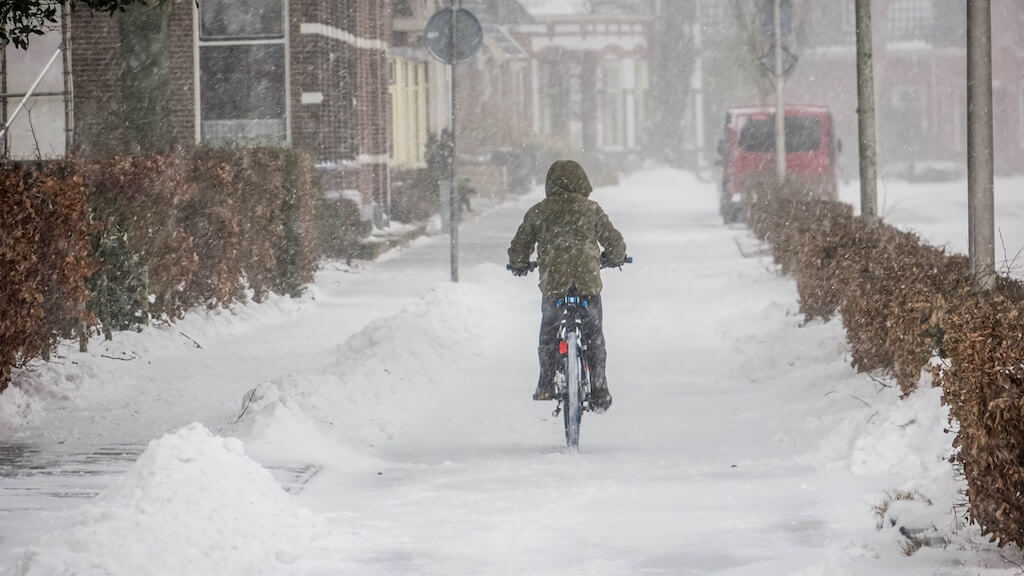Autumn Gear Guide
Find inspiration in our Gear Guide that will keep you out on your bike through wind or rain.
Download NowYes, winter biking tires for commuting in the snow and sleet are a popular and essential item in many regions. Winter cycling can be a delightful experience, but in many parts of Canada and a significant portion of the United States, the presence of snow and ice adds a considerable level of difficulty. While Europeans […]
Yes, winter biking tires for commuting in the snow and sleet are a popular and essential item in many regions.
Winter cycling can be a delightful experience, but in many parts of Canada and a significant portion of the United States, the presence of snow and ice adds a considerable level of difficulty.
While Europeans have showcased their whimsical winter cycling scenes, setting a high standard, North Americans are also making strides despite facing challenges such as longer-than-average commute times, roads heavily focused on cars, and an abundance of pickup trucks in urban areas – do we really need so many of those in the city?
Just six years ago, Canada’s national broadcaster, CBC, questioned the sanity of winter cycling in a headline: “Winter cycling: good idea or flat-out insane?” Fortunately, the good news is that an increasing number of individuals are embracing year-round cycling for recreation, fitness, and commuting purposes.
Montreal, Quebec, stands out as one of the North American cities where cyclists enthusiastically embrace winter cycling with a European flair, making it a unique and vibrant experience.
Momentum checked in with Lamar Timmins of Montreal’s Allo Velo bike shop to shine some light on this very chilly subject.
“I speak more for Montreal, but with the increased bicycle network, and dedicated snow removal by the city, more and more people are choosing to continue cycling in the winter months,” he says. “Over the years the city has tested a variety of methods to make the paths safer like salt, sand, brine, sweeping machines, and plows. It’s a good mix of different formulas, but it’s great that cycling in the winter is recognized by the city.”
Snow clearing of bike lanes is not universal and could take some advocacy work on the part of cyclists. But, many major urban centers have begun. And that’s a great thing. In cities like New York City, snow clearing of bike lanes still takes a back seat to clear the fossil fuel roadways, making getting around on two wheels a serious safety issue.
One question that is often front-and-center when considering the move to Viking biking is whether or not to get a second “beater bike” for the snowy season.
“We welcome and encourage any client of ours to try winter cycling, and it doesn’t have to be complicated or expensive,” Timmins says. “If you don’t want to use your summer commuter bicycle, we recommend finding an older second-hand mountain bike and simply adding winter tires and fenders if it doesn’t already have them. We don’t advise using a high-end bike, as the salt and slush will cause some corrosion, wear and tear. Expect to change your chain, cables, and brakes pads by spring.”
Timmins says older mountain bikes with 26-inch wheels are a good option, as this style will keep your center of gravity a little lower, in addition to having a good gear ratio, wide handlebars for control, and wider tires.
“Most likely, you can make it through the winter, but if it’s your first time even just having a studded tire in the front makes all the difference.”
And that brings us to our second point.

A question people grapple with when the snow approaches are whether or not to invest in winter bicycle tires.
“Here in Montreal, we tend to get a lot of ice build-up due to deep freezes and snow removal (the snowplows remove snow but leave a thin layer of ice). So having studded tires will give you the confidence to ride on icy surfaces,” he says. “Nowadays, you can find most sizes in winter tires. Whether you are riding a Brompton or a cargo bike, there is a winter tire for you.”
Timmins says two main brands are offering high-quality winter tires: Schwalbe and Continental.
“Schwalbe is known for the reputable Marathon Winter ($80) with 120 spikes and WinterPlus with 220 spikes ($120). Continental has done a great job at offering a very durable winter tire at about 2/3 the price of Schwalbe.”
There is the possibility of a DIY version of winter firms by putting screws into a mountain bike tire to recreate the effect, but Timmins says it doesn’t save much money or time.
“The new tires are very affordable and reliable, and can last two-three seasons,” he adds.
Ultimately, riding in the winter doesn’t need to have a steep learning curve, says Timmins.
“It has its challenges (like riding in a snowstorm), but the more you do it the better you become at understanding different snow and ice surfaces,” he says. “Learn to ride slow, especially before turning. Unlike riding in the summer, you cannot lean into your turns. It’s just a great way to keep moving in the winter (we tend to reduce our activities), see your city differently, and get from A to B. Embrace winter!”
For more biking tips on technique and strategy for tackling city streets during the winter see this article.
To support Momentum please visit our page on Patreon. Thank you.
Find inspiration in our Gear Guide that will keep you out on your bike through wind or rain.
Download Now
Leave a comment